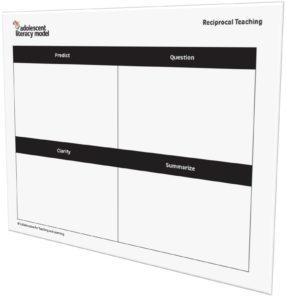STRATEGY FOCUS
RECIPROCAL TEACHING
PURPOSE
Reciprocal Teaching is a collaborative grouping strategy that combines four components of effective reading comprehension into a cohesive process: predicting, clarifying, questioning, and summarizing As students use this strategy, they become more active, reflective, and strategic readers. This strategy provides an opportunity to explicitly scaffold learning to help students become more metacognitive about their reading and learning.

PROCESS
- Identify a text that is accessible to students, but has several places to naturally pause during the reading. This pause time allows students to be able to practice
their skills. - Break the classroom into mixed-ability small groups, assigning each student a role (predictor, clarifier, questioner, summarizer).
- Read the first chunk of text out loud with the small groups, modeling the following three steps of reciprocal teaching:
-
- Before reading, ask students to predict what they think the reading may be about and get them to think about what is going to happen by asking
questions. - When reading aloud, stop at a predetermined spot(s) to have students generate questions as they listen and read along.
- Remind students to ask themselves what words and phrases are unclear to them as they listen and read. They might consider the definition, pronunciation, use of the word, etc.
- Before reading, ask students to predict what they think the reading may be about and get them to think about what is going to happen by asking
- Students repeat the process in their small groups, either reading silently and stopping at predetermined places or using a read aloud strategy. You may want to consider appointing a student as a facilitator with the task of making sure each role gets an opportunity to share
- Within the small groups, have students pair up and summarize verbally or in writing. Students then share key points and different perspectives.
PROBING QUESTIONS
CONSIDERATIONS
- What helped you make predictions about the text?
- Which part did you find the most difficult: predicting, questioning, clarifying, or summarizing? Why?
- How does using these four steps help you comprehend what you are reading?
- The teacher conducts a think-aloud to model for students how they generate questions, identify key points, etc.
- Discuss the various types of questions that students may want to ask: implicit, Explicit, opinion, open-ended, close-ended.
- Review questions (and perhaps create a list of questions) that are appropriate for clarifying vocabulary.
- Use a four square template for students to complete with the four steps of the process.
- Create a rubric of expected behaviors for each role that can help students explicitly develop their skills and help the teacher assess student progress.
CONTENT APPLICATIONS

ENGLISH
LANGUAGE ARTS
Students are grouped into literacy circles. One student becomes the predictor, one the questioner, one the clarifier, and one the summarizer as they discuss the reading.

ARTS & HUMANITIES
Students read a play. Divide into groups of four and assign each student a role. Share predictions, questions, clarification of vocabulary, and summaries aloud with the whole class.
![]()
CAREER & TECHNICAL EDUCATION
Students read an informational text about the drone industry. Track group thinking and generate a series of questions that can help target next steps, as well as create a glossary of important terms.
![]()
SCIENCE
Introduce students to a scientific journal article. Partner students into pairs and complete the template as they predict, question, clarify, and summarize the article.
PDF REPRODUCIBLE

